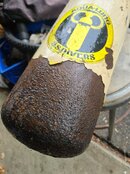CT-Rich
Contributor
We don’t always get to choose our emergencies. I agree about swimming down six lbs, but I am asking a pretty straightforward question. How long would it take to go from buoyant on the surface to neutral. A traditional BCD would be able to go negative in a matter of seconds.In a life or death emergency, you can swim down 6 pounds positive. But an Avelo diver can only be 6 pounds buoyant after finishing a dive with a nearly empty tank, surfacing and blowing any ballast water. Attempting a rescue with low gas and when already Nitrogen loaded is not a good idea no matter what's on your back,
I don’t really have an objection to the system, but I am not really seeing the upside to it either. When I look at successful innovations in diving there is usually an obvious upside. LP inflators and BCDs make maintaining buoyancy at any depth super easy. Dive computers maximize bottom time and reduce task loading. Nitrox increases the NDL on certain dives. They all add costs to diving. I don’t dive nitrox locally because the benefits relative to the price aren’t worth it shore diving to 40’.




